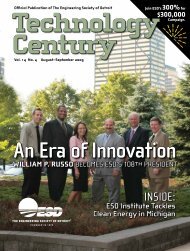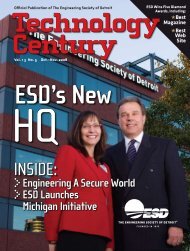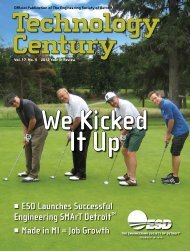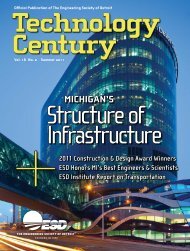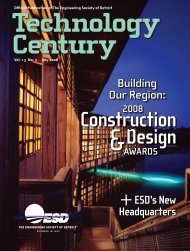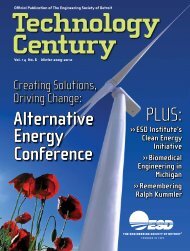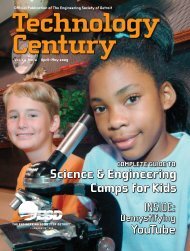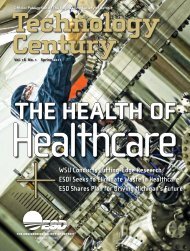Quality Control & Six Sigma - ESD
Quality Control & Six Sigma - ESD
Quality Control & Six Sigma - ESD
- No tags were found...
Create successful ePaper yourself
Turn your PDF publications into a flip-book with our unique Google optimized e-Paper software.
Firms mistakenly believe they are not doing qualifyingR&D or underestimate the amount of their R&D.A firm improved its engineering services so it could providea design methodology to create a unique structural lift.The design methodology was to reduce temporary shoringtowers and to preassemble trusses while on the ground.• Design new manufacturing processesA firm designed improved processes in a manufacturingplant that reduced its client’s material costs and increasedthe number of units that could be made each hour.• Design structures in unique circumstancesA firm improved its engineering services by providing adesign for reinforcing a bridge pier using special structures.The concrete base of the pier had deteriorated, resultingin a long crevice. The challenge was to design a method toencase the pier, to fill the crevice with concrete and then totest the results.• Design of a lift and assembly methodA firm improved its engineering services so it could providea lift and assembly method for placing and installing a newantenna on the top of a skyscraper. The challenge was todesign a crane and to determine where it should be locatedin order to lift and assemble the antenna pieces on top of thebuilding, without interfering with normal building traffic.What is My Tax Credit Potential?Firms that are at least twenty-two years old use one set of rulesto determine their R&D expenditures that can be convertedinto tax credits. Newer firms are called “start-ups” and aregoverned by different rules. The current federal credit alonecan reach 6.5% of a firm’s total qualified R&D related wages,supplies consumed, and 65% of what is paid to contractors thatprovide R&D services to a firm. These credits reduce a firm’s taxliability in the tax year they are incurred. Unused credits can becarried forward for twenty years.An example: Firm A has $10M in gross receipts, uses technologyin its operations, and can qualify $500,000 (5%) ofits expenditures as R&D. Assuming a few questions can beanswered to the good, the annual credit could be $32,500.Many firms can also claim R&D tax credits in three previoustax years and amend their returns to get refunds. In thisexample, Firm A could receive a total of $97,500 in credits forthree past tax years.How Does An R&D Tax Credit Program Work?In a comprehensive R&D tax credit program, technicallytrained investigators first identify a firm’s qualifying R&Dactivities and then find the people involved, the suppliesconsumed and contractors used for each activity. This is doneby personal interviews and reviewing relevant documentation.This method has several benefits over traditional reliance onthe financial records of a firm to identify its R&D.Technical investigators are able to identify more qualifyingactivities, which leads to more qualifying expenditures andcredits. Also, when the technical investigator does a technicalwrite-up of each R&D activity, the firm has a detailed recordto help support the credits claimed should they ever be challenged.This answers the question: Why do these activitiesqualify? Finally, for each identified R&D activity, a spreadsheetof corresponding R&D expenditures (labor, suppliesconsumed, etc.) will be created as part of the final report.This answers the question: How many qualifying expendituresare involved?Timing ConsiderationsTime may be of the essence in claiming R&D tax creditsbecause the right to take credits in the earlier tax years maybe expiring. Many accountants advise their clients to includefiling of R&D tax credits with the original annual return, sothe firm does not have to file an amendment. Also, most firmswant to conduct one comprehensive R&D project that coversall open tax years rather than do one year at a time. So, ifclaiming R&D credits sounds attractive, it makes sense to startthe process as soon as possible to ensure the filing is completedby the tax deadlines and no credits are lost.Andy Walker is president of MonetekLLC, a consulting firm with offices inBloomfield Hills and Grand Rapids,Michigan. Monetek works with a widerange of clients and their tax accountantson new R&D tax credit programs andways to enhance existing programs.An attorney, Mr. Walker has extensiveexperience working with technically oriented attorneys andengineers, has published articles and has given numerouspresentations to groups of tax professionals on R&D tax credits.Contact Mr. Walker at 248-647-2233 or asw@monetek.com.42 | Technology Century | OCTOBER–NOVEMBER 2006




